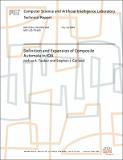| dc.description.abstract | The IOA language provides notations for defining both primitive and composite I/O automata.This note describes, both formally and with examples, the constraints on these definitions, thecomposability requirements for the components of a composite automaton, and the transformationof a composite automaton into an equivalent primitive automaton.Section 2 introduces four examples used throughout this note to illustrate new definitions andoperations. Section 3 treats IOA programs for primitive I/O automata: it introduces notationsfor describing the syntactic structures that appear in these programs, and it lists syntactic andsemantic conditions that these programs must satisfy to represent valid primitive I/O automata.Section 4 describes how to reformulate primitive IOA programs into an equivalent but more regular(desugared) form that is used in later definitions in this note. Section 5 treats IOA programsfor composite I/O automata: it introduces notations for describing the syntactic structures thatappear in these programs, describes resortings induced by them, and lists syntactic and semanticconditions that these programs must satisfy to represent valid composite I/O automata. Section 6describes the translation of the name spaces of component automata into a unified name spacefor the composite automaton. Section 7 shows how to expand an IOA program for a compositeautomaton into an equivalent IOA program for a primitive automaton. The expansion is generatedby combining syntactic structures of the desugared programs for the component automata afterapplying appropriate replacements of sorts and variables. Section 8 details the expansion of thecomposite automaton introduced in Section 2 using the desugared forms developed throughoutSections 4–6 and the techniques described in Section 7. Finally, Section 9 gives a precise definitionof the resortings and substitutions used to replace sorts and variables. | |
